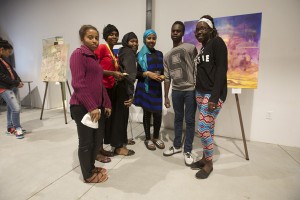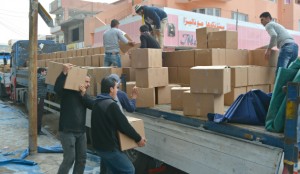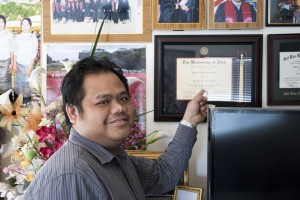
With cold steel pressed against his forehead, he heard the voice of the commander say he was free to go. Just minutes before Joseph Nahas and his family had been sleeping in their home in Freetown, Sierra Leone. Due to the civil war spreading to the capitol city, Nahas and his family were forced to flee their home this same night, leaving behind all possessions. Nahas then carried his pregnant wife, Saran, into the mountains as gunfire trailed behind them, ripping holes through the banana leaves. At this moment Nahas could hardly expect that seeking refuge for his family would eventually take them to Salt Lake City.
These refugees have survived against unbelievable odds; however, most still lack the skills necessary for a fresh start in the States. Different organizations seek to help, but many still lack solutions for allowing refugees to start a stable life in Utah.
According to Patrick Poulin, Salt Lake IRC executive director, Utah welcomes somewhere between 30 and 50 new refugees each month from countries around the world. In the last 14 years the majority of Salt Lake City’s refugees have come from Burma, Iraq, Bhutan, Somalia and Eritrea.
In the 23 years since it opened, the IRC center in Salt Lake City has helped resettle more than 7,500 men, women and children from more than 15 nations, according to a USCCB report.
Pamela Perlich, a senior research economist with the Bureau of Economic and Business Research at the University of Utah, said, “We wonder why Utah has emerged recently as a gateway for immigrants. People have come to Utah because we have become a place of economic opportunity and also because we are a refugee-receiving community.”
There are two main nonprofit agencies responsible for the resettlement of refugees in Utah: Catholic Community Services and the International Rescue Committee. These agencies take care of necessities such as initial transportation, finding housing and providing educational opportunities for refugees.
Although there are multiple resettlement agencies that all share a common goal, the IRC is arguably the most established, far-reaching program, as it is mostly funded by the government and has centers located all over the world, including 22 different states in the U.S.
Even with the obstacles the IRC employees face they continue to provide refugees with a long list of services, including reception, placement, case management, orientation, healthcare, employment and immigration assistance, in order to help refugees integrate into their new environment as seamlessly as possible.
Despite all of the efforts, refugees still find that life in America is harder than expected. Nahas, who didn’t receive his first job until being in Salt Lake City for three years, said, “When you are coming to America all you think is that it is the end of poverty, the end of your sorrow, the end of war, the end of difficult times.”
Despite his optimism, Nahas soon learned, refugees have many obstacles to overcome, even after they make it to the States.
Andy Tran, a clinical director for the community wellness program at Asian Association of Utah, is himself a refugee from Vietnam. His family went to Hong Kong to escape the war.
In terms of refugees, Tran said, one of the things that is important for people to understand is that refugees have experienced traumatic experiences — whether that be the loss of a loved one or the loss of their country.
“I think one of the things to understand is that refugees are very resilient; in the hardships that they’ve gone through they still have hope. They want to come here to America to have a better future,” Tran said.
When asked about some of the biggest hurdles refugees face once they arrive in Utah, Tran said, “Language barrier is huge; a lot of the current jobs we do here in the U.S. require you have to have particular skills, and many refugees haven’t had opportunities to learn these skills. Many refugees have lived in refugee camps where they have spent 20–30 years of their life.”
Banyar Marn is a refugee who spent more than 12 years in a refugee camp. Marn fled his home in Burma just as soldiers were heading to his house to arrest him for his political advocacy of democracy. He ended up in a refugee camp in Bangkok, Thailand.
“When some people hear about refugees they think that they are uneducated,” he said. But according to Marn, 50 percent of the people in his home country are educated and get to attend school.
“When we come over here, we go back to school,” said Marn, who has since completed an advanced degree at the University of Utah. While some refugees had the opportunity to attend a university in their homeland, others have spent their entire life in a refugee camp with little to no education. Unfortunately, it often takes years until refugees are stabilized enough with work, English, transportation and culture before they can even think about going back to school.
The Mabika family, from the Democratic Republic of Congo, is experiencing these specific challenges firsthand. In mid-December 2014, 28-year-old Aminata Mabika and her five children left everything they knew in hopes of having a better life in Salt Lake City. Her children, whose ages span from 2 to 11, followed their mother with nothing but the clothes on their backs to a place they knew nothing about.

According to IRC coordinator Jesse Sheets, most refugees wait between 5 and 20 years for citizenship. “It’s a very lengthy process,” Sheets said. “As you can imagine, with all of the government agencies involved, they have to wait during the process of approval and then wait even more for the paperwork and everything to be taken care of.
“After they have received refugee status, they go through the security process, which can also take a very long time, especially if their name happens to be similar to someone who is on an international watch list or something along those lines,” he said.
It’s not necessarily a free ride to the United States. After six months, the loan refugees receive from the International Office of Migration for travel expenses needs to start being paid back.
This task is obviously much easier said than done. For Mabika, it meant that after getting her bearings in her first formal home with running water, beds, kitchen appliances and light switches, she needed to also enroll her children in school, apply for a green card, meet with the IRC health team and begin seeking employment.
Luckily, the IRC has staff and volunteers to help Mabika with these tasks along the way. However, there are still some major difficulties that arise throughout this process. Not only does Mabika not speak any English, she speaks a Congolese language so rare it’s not translatable through any online translators.
Laura Hughes, a college student and IRC volunteer who helped Mabika with bus orientations, said it is extremely difficult to show Mabika how to use public transportation to get to necessary everyday destinations like her children’s school, the grocery store and their apartment complex.
“I have lived here for over 20 years, and I still get turned around in this city,” Hughes said.
Hughes went on to say she is fortunate enough to speak the language and have GoogleMaps on her phone. Mabika does not have these resources yet. For these reasons, Hughes said, it’s really hard to try to help her understand and remember these things just by basic maps and practicing a few times, especially when they can only communicate with basic hand gestures.
Hughes has been riding the bus with Mabika to and from different locations, including a school that provides English as a Second Language (ESL) placement testing and classes. Although things are going a little more smoothly, it will continue to be an inevitable challenge for refugees and volunteers, she said.

A refugee cannot return home because of a well-founded fear of persecution based on multiple things, some of those being race, nationality, religion, political opinion, social group and sometimes even career. “Something as simple as the occupation that you held can be a reason why it would be dangerous for you to live in the country that you were living in,” Sheets said.
The Refugee Services Office estimates that there are 60,000 or more refugees in Salt Lake County who came as refugees or are the children of those who came as refugees since the fall of Vietnam in 1975.
According to the United Nations High Commissioner of Refugees, which is the moving force that channels refugees around the world, the estimated number of forcibly displaced persons has reached more than 51 million people, about 16 million of which are classified as refugees.
Of those, only about 1 percent are resettled into a third country, and out of that 1 percent, the United States resettles about 70,000 per year, making the U.S. the second main destination for new asylum seekers, after South Africa, according to a UNHCR report.
“Pre 9/11 that number was much higher,” said Lyn Spataro, head volunteer coordinator at the IRC. “The United States cap was closer to 120,000 refugees per year. But ever since then, every fall, the president signs a declaration of how many we are able to accept, and starting in 2002 it dropped significantly, and ever since then it has stayed the same, at about 60,000–80,000.”
As IRC staff continues to find more organized and efficient ways for managing such large flows of diverse individuals, volunteers are needed to fill in the holes.
To utilize the talents of refugee people, first the community has to help them get started. “Refugees, which are very potent potential asset, can become a liability if they don’t learn English and aren’t given opportunity to do so,” said Gerald Brown, director of the Refugee Services Office.
“Initially I got involved because I studied Arabic in college and wanted to put my skills to use, but I ended up really bonding with this family, and now they are just like friends that I love hanging out with,” she said.
“Some people believe that Utah is one of the few places refugees are resettled, all states in the U.S. except Wyoming resettle refugees,” Brown said. “Out of the 49 states we’re ranked 23 for number of people who are resettled.”
Brown considers Utah lucky to have refugees. “I think they’re heroes, people of resilience. I think we’re better off to have them. They have different traditions and life experiences; they have our basic values but are also better on some values that we claim are important, like the way they treat older people.”
Brown supports the diversity these refugees bring. “If everyone thinks alike we’re doomed. I think the U.S. is so successful because we’re made of people from all over the world. Refugee resettlement programs continue that here.”
For more information about how you can get involved, visit: https://www.rescue.org/volunteer




